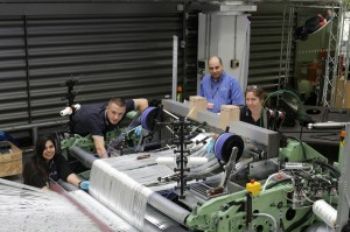
Composite experts at the University of Sheffield Advanced Manufacturing Research Centre with Boeing (AMRC) are hoping to shed some light on this technology’s ‘dark arts’ with the help of some traditional Yorkshire skills.
The AMRC’s Composite Centre has invested £150,000 in an FT Dornier Rapier Loom, specially designed to weave composites without the risk of the highly electrically conductive carbon fibres causing it to short-circuit.
The loom takes the composites team into a whole new area. In the past, team members have been limited to using commercially available woven reinforcing materials.
Now, they will be able to design and weave their own materials, allowing them to push the boundaries of processes like resin transfer moulding (RTM), where components are made by injecting resin into a mould in which dry fibre has been laid down.
The AMRC Composite Centre’s Jody Turner says: “RTM is a bit of a ‘dark art’. The process is supposed to be a very rapid and highly production-orientated process, but getting it right can involve trial and error.
“Sometimes the resin doesn’t penetrate all of the material, and parts of the component are left completely dry, making it useless. We plan to carry out research that will help us to understand more about what happens during RTM injection and why results can be so erratic.”
Composite Centre researchers, who have already been studying how resin flows through fabrics made from carbon fibre, found that he resin flow through the fabric isn’t uniform, despite the weave pattern being perfectly symmetrical.
They believe this may be caused by slightly differing yarn tensions within the fabric, and they hope to increase their knowledge by experimenting with different tensions for the warp (the long continuous threads) and the weft (the thread that is fed across between the warp threads).
“If we can control warp and weft tension, we might be able to influence resin flow. We also want to push the machine to the limit of its capabilities. For example, it isn’t designed to produce three-dimensional structures, but we are hoping to create structures like pockets and flaps.”
The researchers hope to develop the ability to weave materials that could be opened up to form a series of boxes or a honeycomb structure that would give the completed composite component more strength.